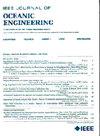基于深度测量的自主水下机器人贝叶斯定位方法定量评价
IF 5.3
2区 工程技术
Q1 ENGINEERING, CIVIL
引用次数: 0
摘要
本文对自主水下航行器(auv)基于测深定位的四种概率算法进行了评估。该算法使用四种不同的贝叶斯滤波器(扩展卡尔曼滤波器、无气味卡尔曼滤波器、粒子滤波器和边缘滤波(MPF))将先验的水深信息与深度和距离测量融合在一起,对水下AUV进行定位。我们利用机器人操作系统(ROS)开发了算法,利用ROS Gazebo建立了一个真实的仿真平台,并结合现实世界的水深测量,并在现实世界的湖泊数据上评估了这四种基于贝叶斯水深测量的AUV定位方法的性能。该仿真允许对算法进行评估,以准确了解机器人的真实位置,否则在水下无法获得真实位置。通过依赖深度传感器和回声测深仪的数据,定位算法克服了基于视觉地标的定位所面临的挑战。我们的结果显示了每种算法在各种条件下的有效性,一般来说,MPF是最准确的。本文章由计算机程序翻译,如有差异,请以英文原文为准。
A Quantitative Evaluation of Bathymetry-Based Bayesian Localization Methods for Autonomous Underwater Robots
This article presents an evaluation of four probabilistic algorithms for bathymetry-based localization of autonomous underwater vehicles (AUVs). The algorithms fuse a priori bathymetry information with depth and range measurements to localize an AUV underwater using four different Bayes filters [extended Kalman filter, unscented Kalman filter, particle filter, and marginalized PF (MPF)]. We develop the algorithms using the robot operating system (ROS), build a realistic simulation platform using ROS Gazebo incorporating real-world bathymetry, and evaluate the performance of these four Bayesian bathymetry-based AUV localization approaches on real-world lake data. The simulation allows the evaluation of algorithms with accurate knowledge of the robot's true location, which is otherwise infeasible to obtain underwater in the field. By relying on the data from a depth sensor and echo sounder, the localization algorithms overcome challenges faced by visual landmark-based localization. Our results show the efficacy of each algorithm under a variety of conditions, with the MPF being the most accurate in general.
求助全文
通过发布文献求助,成功后即可免费获取论文全文。
去求助
来源期刊

IEEE Journal of Oceanic Engineering
工程技术-工程:大洋
CiteScore
9.60
自引率
12.20%
发文量
86
审稿时长
12 months
期刊介绍:
The IEEE Journal of Oceanic Engineering (ISSN 0364-9059) is the online-only quarterly publication of the IEEE Oceanic Engineering Society (IEEE OES). The scope of the Journal is the field of interest of the IEEE OES, which encompasses all aspects of science, engineering, and technology that address research, development, and operations pertaining to all bodies of water. This includes the creation of new capabilities and technologies from concept design through prototypes, testing, and operational systems to sense, explore, understand, develop, use, and responsibly manage natural resources.
 求助内容:
求助内容: 应助结果提醒方式:
应助结果提醒方式:


